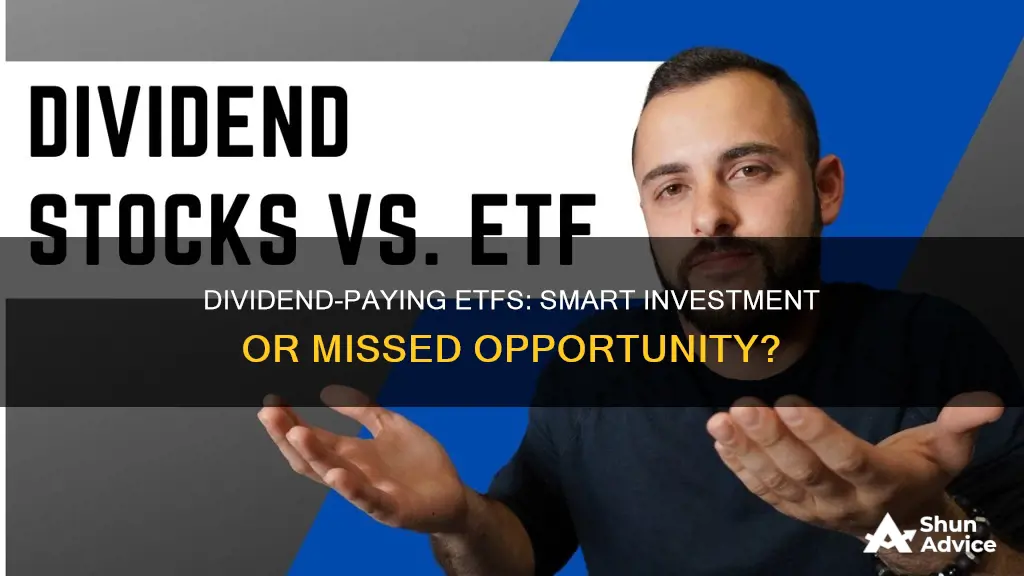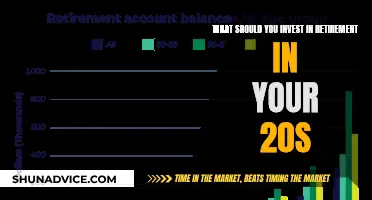
Dividend ETFs are exchange-traded funds that hold stocks with a strong history of paying dividends to their shareholders. They are a good investment option for investors who are risk-averse and income-seeking. Dividend ETFs can provide a stream of income and long-term growth. They are also a great way to build wealth over time, as growing companies distribute earnings to their shareholders.
However, it's important to remember that dividend payments are not guaranteed. When choosing a dividend ETF, it's crucial to consider the fund's strategy, which is usually outlined on its website or prospectus. The screening process used to identify dividend-paying stocks and the fund's investment approach should be clear.
Some popular dividend ETFs include:
- Vanguard Dividend Appreciation ETF (VIG)
- Fidelity International High Dividend ETF (FIDI)
- iShares Core High Dividend ETF (HDV)
- SPDR S&P Global Dividend ETF (WDIV)
- Schwab US Equity Dividend ETF (SCHD)
What You'll Learn

What are dividend ETFs?
Dividend ETFs (exchange-traded funds) are a type of investment fund that focuses on dividend-paying securities. They are designed to provide investors with a regular income stream by investing in a basket of stocks that pay out dividends. Dividend ETFs are typically passively managed, meaning they track a specific dividend index, and the fund manager does not need to make frequent trading decisions.
Dividend ETFs can be an attractive investment option for those seeking income and long-term growth while also diversifying their portfolio. By investing in a dividend ETF, individuals gain exposure to a broad range of dividend-paying stocks, reducing the risk associated with individual stocks. The fund manager selects a portfolio of stocks based on a dividend index, which pays out dividends to investors.
Dividend ETFs can be further categorised into different types, such as high-dividend ETFs, international dividend ETFs, real estate dividend ETFs, and dividend aristocrat ETFs. High-dividend ETFs focus on companies with above-average dividend payments, while international dividend ETFs invest in companies based outside of the U.S. Real estate dividend ETFs invest in shares of companies that deal with income-producing real estate, and dividend aristocrat ETFs are considered the gold standard for consistent and steady dividend income.
When choosing a dividend ETF, investors should consider factors such as dividend yield, dividend growth, and dividend quality. Dividend yield refers to the percentage of the purchase price paid in dividends over the previous 12 months. Dividend growth looks at the consistency of dividend payments over time, and dividend quality assesses the creditworthiness of the stocks in the ETF. Additionally, factors like expense ratios, stock size, and assets under management (AUM) can also impact the performance and risk profile of a dividend ETF.
Overall, dividend ETFs offer a convenient way to pursue income investing and can be a good option for those seeking diversification, low fees, liquidity, transparency, and tax efficiency. However, it's important to remember that dividend payments are not guaranteed, and there are associated risks, including market volatility and the potential for companies to reduce or suspend dividend payments.
China's Bubble: Global Investment Risk
You may want to see also

Pros and cons of dividend ETFs
Dividend ETFs (exchange-traded funds) are funds that invest exclusively in dividend-paying companies. They are a good investment option for investors who are risk-averse and income-seeking. Here are some pros and cons to consider:
Pros of Dividend ETFs:
- Portfolio Diversification: Dividend ETFs offer diversification by investing in a basket of dividend-paying stocks, reducing the risk of exposure to individual assets.
- Income Generation: Dividend ETFs can provide a regular stream of income through dividend payments.
- Long-Term Growth: Dividend ETFs can offer long-term growth potential as they invest in companies with a history of distributing dividends, which indicates financial stability and growth.
- Potentially Lower Risk: Companies that pay regular dividends tend to be more financially stable and less risky than those focused on rapid growth.
- Passive Income: Dividend ETFs are passively managed, meaning the fund manager follows an index and does not have to make frequent trading decisions, providing a more hands-off approach for investors.
- Lower Fees: ETFs typically have lower expense ratios than other investment vehicles, such as mutual funds.
Cons of Dividend ETFs:
- No Guarantee of Dividends: Dividend payments are not guaranteed and can be reduced or suspended at any time, impacting the ETF's performance.
- Stock Price Volatility: Stock price declines may offset the yield, and high-yielding dividend stocks may be more volatile and susceptible to market downturns.
- Tax Implications: Dividends are taxed as regular income in the year they are distributed to shareholders, which can impact overall returns.
- Blended Yield: Due to the nature of ETFs, investors receive a blended yield from the various underlying investments, which may be less favourable than individual stock dividends.
- Lack of Control: In a dividend ETF, investors do not control the income generated, which may be a disadvantage for those seeking more active investment strategies.
Crypto Investments: Legal or Not?
You may want to see also

How to choose a dividend ETF
Dividend-paying ETFs can be a great tool for those looking to increase cash flow and diversify their investments. They offer a simple solution to getting exposure to a specific investing niche—in this case, stocks that pay a regular dividend.
- Determine your financial goals: The type of investments you choose depends on what you are trying to achieve. For example, if you are about to retire, you will likely want to take a more conservative approach to investing. So always let your financial objectives drive your decision-making.
- Research dividend funds: When selecting dividend ETFs, pay attention to factors like dividend history, dividend yield, the fund's performance, expense ratios, top holdings, and assets under management. You can find this information in a fund's prospectus.
- Outline your asset mix: Before investing, do an inventory of what you own and how you want to allocate your assets. Remember, the key is to remain diversified.
- Know what you own: By periodically reviewing your investments, you can take charge of your finances and make any necessary adjustments. Leverage any free resources from your broker, such as meeting with a financial planner, and always ask questions. Ultimately, there is no such thing as a hands-off investment.
- Look beyond the current yield: When selecting a dividend ETF, investors should look beyond the fund's current yield. Consider the dividend yield in the context of its historical values and relative to the current and historical values for comparable strategies.
- Consider dividend growth: Dividend growth is a vital component of the overall income equation, as it will determine whether your income stream will lag or keep pace with the rate of inflation. Look for funds that can grow their dividends at an inflation-plus rate over the long haul.
- Focus on dividend durability: The stability of the dividend income stream is crucial, especially for investors relying on these funds as a source of cash flow. During the financial crisis, ETFs that screened their constituents based on a steady history of paying and growing dividends had relatively muted dividend drawdowns.
- Dividend quality: This refers to the quality and creditworthiness of the stocks owned by the ETF. If the fund owns riskier companies with lower credit ratings, there is a higher likelihood that the value of the fund will decline.
- 5-year returns: Generally, higher returns are better.
- Expense ratio: This is the ETF's annual fee, paid out of your investment in the fund. Look for an expense ratio that is under 0.50%, but lower is better.
- Stock size: Dividend ETFs can be invested in companies with large, medium, or small market capitalizations. Larger companies are generally the safest, while smaller companies are the riskiest.
- Assets under management (AUM): This refers to the total market value of the assets a fund manages and gives an indication of the fund's size. Funds with a low AUM promising high dividends may be risky.
Invest Now: Where to Put Your Money
You may want to see also

How to invest in dividend ETFs
Dividend-paying ETFs can be a great tool for those looking to increase cash flow and diversify their investments. They offer a simple solution to getting exposure to a specific investing niche—in this case, stocks that pay a regular dividend.
- Find a broadly diversified dividend ETF: You can typically find dividend ETFs by searching for them on your broker's website. If you don't have a broker, you'll need to open a brokerage account.
- Analyze the ETF: Make sure the ETF is invested in stocks (also called equities), not bonds. Check the dividend yield, 5-year returns, expense ratio, stock size, and assets under management (AUM).
- Buy the ETF: You can buy ETFs just like you'd buy a stock—through an online broker. Consider buying them regularly to take advantage of dollar-cost averaging.
- Reinvesting dividends: You can choose to reinvest dividends back into the fund to better take advantage of compound interest and grow your investment portfolio.
- Taxes: Dividends are taxed in the year they are distributed to shareholders. Qualified dividends are taxed at lower rates than ordinary income, such as long-term capital gains.
- Risk: Dividend ETFs are not risk-free investments. Companies can reduce or suspend their dividend payments at any time, which can impact the performance of the ETF.
- Vanguard International High Dividend Yield ETF (VYMI)
- Invesco S&P 500 High Dividend Low Volatility ETF (SPHD)
- WisdomTree U.S. SmallCap Dividend Fund (DES)
- FCF International Quality ETF (TTAI)
- Invesco High Yield Equity Dividend Achievers ETF (PEY)
- Schwab U.S. Dividend Equity ETF (SCHD)
- Fidelity High Dividend ETF (FDVV)
Turkey: Invest Now or Later?
You may want to see also

Can you live off ETF dividends?
Dividend-paying stocks, mutual funds, and exchange-traded funds (ETFs) can be a great way to enhance your retirement income. Dividend payments can supplement your Social Security and pension income, and in some cases, they can even provide all the money you need to maintain your pre-retirement lifestyle.
Dividend income can be a welcome supplement to other income sources, such as Social Security benefits, pension benefits, and withdrawals from tax-advantaged accounts. It's important to note that not all stocks generate dividends, and even among dividend-paying stocks, the payout amounts and frequencies can vary.
When planning to live off dividend income, it's crucial to find the right balance between the income generated by your investments and your spending rate. Factors such as your retirement age, expected longevity, and retirement needs should be considered in your calculations. For example, the 4% rule is a commonly used guideline, which suggests that retirees can safely withdraw 4% of their investment portfolio each year without depleting their funds too quickly.
To live off dividends, you should first determine how much you can realistically withdraw from your portfolio and consider other income sources. Social Security, pension benefits, and withdrawals from retirement accounts like a 401(k) or IRA may need to be factored in. Estimating your expected expenses in retirement can help you identify how much dividend income you'll need to fill any gaps.
Additionally, taxes play a significant role in planning for dividend income. Dividends may be subject to capital gains tax, so it's important to diversify your investments using both tax-advantaged and taxable accounts. Even if you reinvest dividends through a dividend reinvestment plan (DRIP), they are still taxable. Consulting a financial advisor or tax professional can help you optimise your asset location and allocation for dividend income investing.
There are two main approaches to building a dividend-focused portfolio: investing in individual dividend-paying stocks or holding dividend funds, such as mutual funds or ETFs. Investing in individual dividend stocks offers the advantage of choosing companies that align with your risk tolerance and dividend goals. When selecting individual stocks, it's important to consider factors such as dividend payout ratios, company fundamentals, dividend yield, consistency of dividend payments, and the sustainability of the current dividend payout.
On the other hand, dividend funds, such as mutual funds or ETFs, provide a simpler way to diversify your dividend stock holdings. These funds typically employ specific strategies, such as mimicking a benchmark index or focusing on stocks with high dividend yields or growth potential. It's essential to consider the fund's strategy and how it aligns with your investment goals. Additionally, cost considerations, such as brokerage fees and expense ratios, should be factored into your decision-making process.
While it is possible to live off dividend income, it requires careful planning and consideration of various factors. Dividend investing offers a simple solution to generating passive income in retirement, but it's important to remember that dividend payments are not guaranteed, and there are certain risks associated with this investment strategy.
Mark Cuban's Current Investment Interests
You may want to see also
Frequently asked questions
A dividend ETF is an exchange-traded fund (ETF) that invests in a portfolio of dividend-paying stocks. The fund manager selects these stocks based on specific attributes such as size, industry, geographic region, and dividend history. Dividend ETFs are passively managed, meaning they track a specific index and do not require frequent trading decisions.
Dividend ETFs offer several advantages, including portfolio diversification, potential income generation, and long-term growth. They provide instant diversification by investing in a wide range of dividend-paying stocks, reducing the risk associated with individual stocks. Dividend ETFs can also generate regular income through dividend distributions, which can be attractive for investors seeking cash flow. Additionally, they may offer long-term growth potential as the underlying stocks can increase in value over time.
When selecting a dividend ETF, consider factors such as dividend yield, dividend growth, and dividend quality. Evaluate the fund's strategy, screening process, and investment approach. Look for ETFs with a strong history of dividend payments and stable companies with low credit risk. Compare expense ratios, which represent the annual fee charged by the fund, and aim for ratios below 0.50% or lower if possible.
While dividend ETFs offer potential benefits, it's important to consider the risks. Dividend payments are not guaranteed, and there is no assurance of future dividends. Stock price declines may offset the yield, and dividends are typically taxed in the year they are distributed to shareholders. Additionally, some dividend ETFs may invest in riskier assets or use complex trading strategies, leading to higher volatility.
You can invest in dividend ETFs through an online broker. Start by finding a broadly diversified dividend ETF that focuses on dividend-paying stocks from a diverse range of industries and sectors. Analyze the ETF's dividend yield, historical returns, expense ratio, and the size of the companies it invests in (market capitalization). Consider buying ETFs regularly to benefit from dollar-cost averaging, which can help smooth out market fluctuations.







